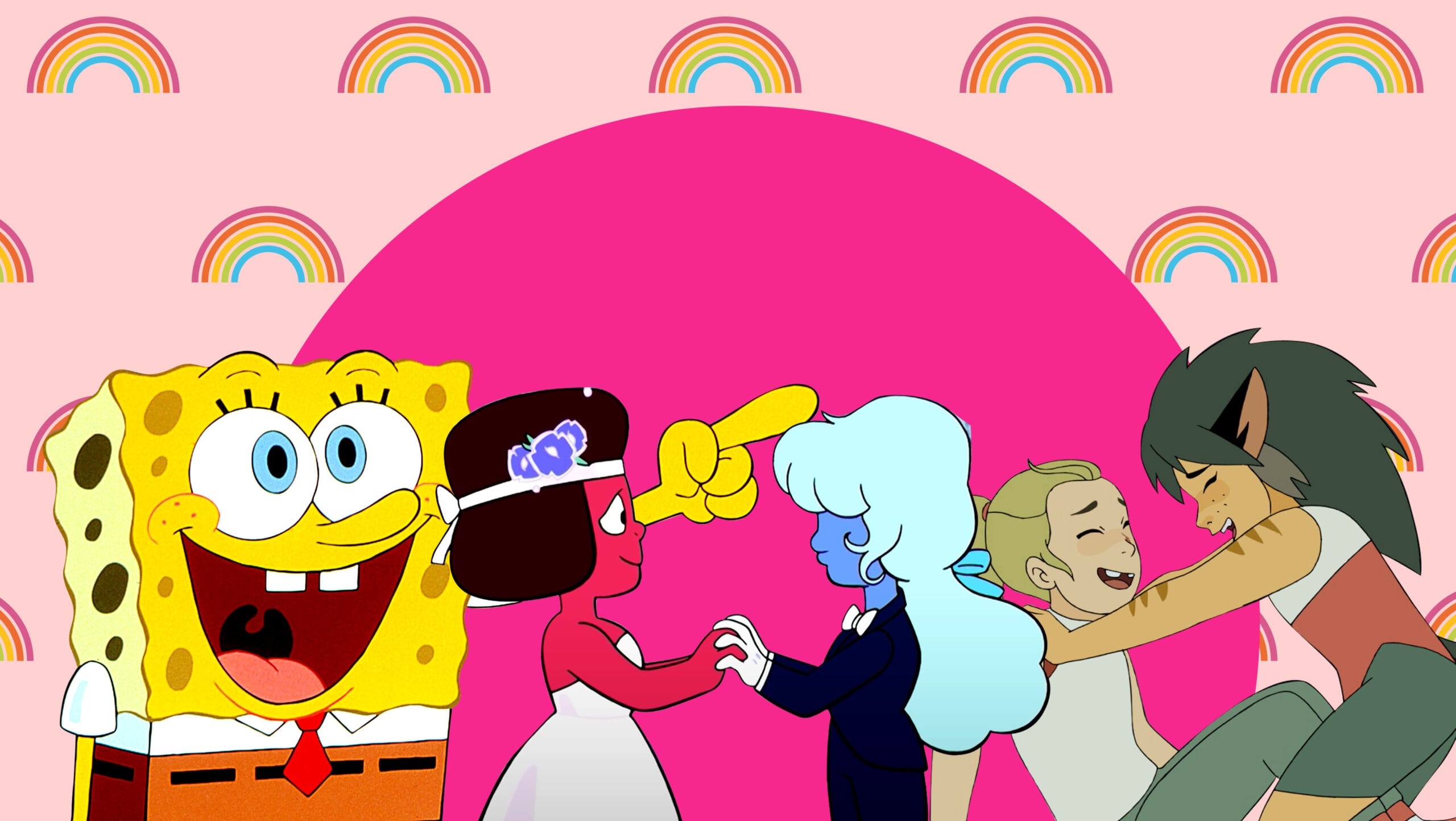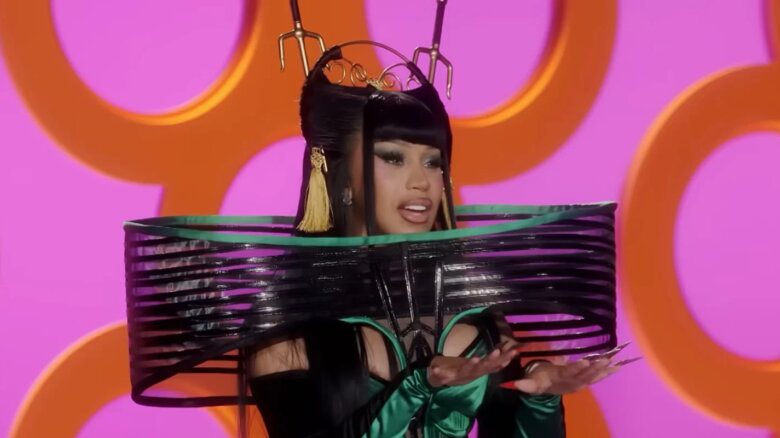Editor’s note: Spoilers ahead for She-Ra and the Princesses of Power, Steven Universe, The Legend of Korra, Kipo and the Age of Wonderbeasts, Voltron, The Hollow, The Owl House and Adventure Time.
In Episode 6 of the animated series Kipo and the Age of Wonderbeasts, Kipo and Benson are riding a ferris wheel. “I think I like you,” Kipo says shyly, looking up from under her baby-pink bangs as the music swells. “Oh! Oh. Oh,” says Benson. The music cuts abruptly. “You should know something,” he says. “I’m gay.”
Kipo is momentarily embarrassed. “I’m glad we’re friends,” she manages, and they share a hug. Then a giant two-headed flamingo shows up. Kipo and Benson are still friends, and they clearly have more important things to do than discuss Benson’s love of boys.
It’s been a banner year for queer all-age animation like Kipo and the Age of the Wonderbeasts—and we’re only halfway through 2020. So far, Benson is one of the first cartoon characters to say the words “I’m gay.” Meanwhile, Scooby-Doo! creators confirmed Velma is a lesbian, and Nickelodeon put SpongeBob SqaurePants in their Pride post (according to a 15-year-old interview, SpongeBob is “somewhat asexual,” an important part of the LGBTQ2 community).
Granted, cartoons have been queer for a long time. Japanese animated shows have always been willing to play with gender—as is obvious by the Wikipedia entry of LGBTQ characters in animation—but Western media has taken longer to warm up to the idea. Part of that is because cartoons in Japan aren’t marketed to children the same way they are in the West. Content for children was subject to censorship: The English dubs of late 1990s and early 2000s shows like Sailor Moon and Cardcaptor Sakura stripped out all queer content, preferring to cut episodes or entire seasons rather than hint at what some TV execs deemed provocative themes.
That these displays of queerness have persisted in animation can be attributed to the medium’s relative fluidity: There’s a freedom in drawing—to create people and worlds that don’t look like the ones we normally inhabit, who can change from frame to frame. This lack of rules means, as writer and animator Paul Wells (no relation) writes, “the body in animation is a form constantly in flux.” Bugs Bunny gained eyelashes when in drag, and Mulan’s jaw became magically squarer when she presented as Ping. Emma A. Jane, in a paper about Adventure Time, writes that “the usual ‘laws’ of gender binaries—like the usual laws of physics—simply do not apply.” In cartoon worlds where characters control fire, explore space or wield magic swords, why should the real world’s cis-heteronormative assumptions apply either?
That may be, in part, why the last decade has seen an unprecedented shift in queer representation in kids’ cartoons. And as animated shows tackle more complex issues, more adults are drawn to them. Shows for all ages are also often gentler and kinder than properties made for grown-ups: You expect the good guys to win in the end, and that bad things will get better. Queer people have always been reading characters as queer, even when they’re not, because we want to exist in these universes. Seeing ourselves reflected back in kid-friendly spaces is a reminder that we, in our messy adolescences and baby-gay childhoods, always belonged here.
In 2014, gifs of Korra and Asami from The Legend of Korra (2012 to 2014) overran fan blogs on Tumblr. The final shot of the show—illustrating the two women holding hands and staring into each other’s eyes—was confirmed as a canonical depiction of a same-sex relationship on the show’s co-creator Bryan Konietzko’s blog. Vanity Fair later said the episode “changed the face of TV” as the first same-sex romance in all-ages animation. While that accolade might be hyperbolic (plenty of other non-Western shows did so well before The Legend of Korra), the showrunners knew the network was reticent to let them show anything overtly queer. “Was it a slam-dunk victory for queer representation?… Hopefully it is a somewhat significant inching forward,” Konietzko wrote.
Around the same time, Steven Universe (2013 to 2019) was pushing the envelope for queer representation in cartoons. The main character, Steven, and his father are the only major male characters on a show full of women (and female-coded, genderless space aliens). While Korra and Asami are queer characters in a straight show, Steven Universe is a queer show, full stop. The show began by promoting the very queer notion of found families—Steven is raised by three moms—and gradually got more queer as episodes progressed. By 2015, Steven Universe had introduced an intersex non-binary character (Stevonnie, a fusion of Steven and his best friend Connie), and revealed that stoic mom Garnet was a fusion of two gems, Sapphire and Ruby. Pearl, the most Virgo of Steven’s moms, was also in love with his now-dead mother.
Like The Legend of Korra, there were hurdles in production. Rebecca Sugar, the non-binary bisexual creator of Steven Universe, expressed in an interview with EW in 2018 just how tough it was to get a queer cartoon on the air: “Please know that when we started doing this in 2011 it was impossible and it has become possible over the last many years of working really hard to do this.”
“Even beyond character representation, Steven Universe is deeply queer: Problems are resolved with communication and empathy rather than violence, and toxic masculinity doesn’t exist”
But unlike The Legend of Korra—or even Adventure Time’s final episode kiss between Marceline and Princess Bubblegum—same-sex romance wasn’t crammed into the season finale. Steven Universe is full of thoughtful queer interactions, with a multitude of relationships showing the different kinds of love through the entire course of the show. Ruby and Sapphire’s wedding had an entire storyline of its own. In every scene afterwards, Garnet’s shown wearing a wedding ring on each hand—a reminder that she’s literally made of love. Even beyond character representation, the show is deeply queer: Problems are resolved with communication and empathy rather than violence, and toxic masculinity doesn’t exist. There’s even an academic book, “Representation in Steven Universe,” dedicated to analyzing the show’s portrayal of queerness, race and colonialism.
Following in Steven Universe’s footsteps, She-Ra and The Princesses of Power (2018 to 2020) is both a continually queer show and one with a Big Gay Finale. Tech archer Bow has two loving Black dads; butch icon Scorpia has two (dead) moms; side characters Spinnerella and Netossa are a married lesbian couple who kiss on-screen in Season 5; and almost every character expresses interest in their same-sex cohorts. Princess Perfuma stares wide-eyed at every muscled woman she meets, while Bow swoons over dashing mustachioed sailor Sea Hawk. A non-binary shapeshifter called Double Trouble, voiced by non-binary powerhouse Jacob Tobia, is responsible for most of the plot in the fourth season. Magic is drawn as glowing rainbows.
At the core of the She-Ra, though, is the push-and-pull between brave jock Adora and her childhood best friend Catra. In the first episode, Adora leaves the evil Horde and joins the rebellion to free the planet, while Catra stays behind and rises through the ranks. The storyline has a Killing Eve tension, where two powerful women circle each other, fighting as a proxy for making out. Catra eventually joins the good guys in the final season. The climax of the entire show is an anguished declaration of love: Adora is in the throes of a deathbed fever dream, and Catra is wrapped around her. “Don’t you get it? I love you,” Catra says through tears. “I always have. So please, just this once, stay.” Their kiss is literal magic: Rainbow energy erupts across the screen. Their love saves the universe. For a show so comfortable with same-sex characters, of course there was no other way for it to end than in life-saving lesbianism.
Like Steven Universe, She-Ra is helmed by a queer person: Non-binary lesbian Noelle Stevenson. Stevenson credits Sugar with breaking boundaries: “Steven Universe changed the landscape of animated shows when it first hit the air.” While queer people can, of course, make very heterosexual art, we are drawn to putting stories into the world that we are missing—and often that means queer ones.
“For a show so comfortable with same-sex characters, of course there was no other way for She-Ra to end than in life-saving lesbianism”
Even more recently, The Owl House—steered by openly bisexual showrunner Dana Terrace—is making waves as the first Disney Channel cartoon to have a queer main character. “I’m bi! I want to write a bi character, dammit!” Terrace tweeted, hinting that the romance between green-haired witch Amity and earnest dork Luz will see more development.
That’s not to say all cartoons have nailed representation. Gay male characters are few and far between: Voltron made a popular character, Shiro, gay, but subsequently removed all his friendships with men in case they were perceived as romantic instead of platonic. The showrunners also killed his boyfriend off-screen and had Shiro marry a background character in the series finale as a half-hearted attempt at making amends. In Arthur, teacher Mr. Ratburn got married, but his husband hasn’t been seen in any episodes since. Disney’s Gravity Falls also features gay cops Blubs and Durland; but their relationship was confirmed in the final episode when the network “wouldn’t have to deal” with the showrunner anymore. And while Adam, the main character of The Hollow, is gay, he came out to explain why he isn’t interested in a girl—and doesn’t seem into any boys.
There’s also a dearth of trans characters. Non-binary characters—like She-Ra’s reptilian Double Trouble and Steven Universe’s human-gem fusion Stevonnie and even Adventure Time’s sentient games console BMO—are overwhelmingly non-human, making their nonconformity more acceptable than if they were human. (Steven Universe does have a non-binary guest character in its final season, voiced by Indya Moore.) The most notable binary trans character, Jewelstar in She-Ra, is trans by subtext: He’s based on a character who was female in the ’80s version of the show and is voiced by trans man Alex Blue Davis for the single episode he appears in.
While TV continues to grow more diverse, there’s a special place in my heart for cartoons. They can tell difficult, complex and nuanced stories without milking queerness for pain. We don’t have to see queer characters in all-ages shows die tragically young, or be forcibly outed or disowned by their families, or any of the other terrible things that happen to too many of us in real life that we see turned into stock tropes on the screen. Steven Universe deals with mental illness and grief, She-Ra with parental abuse and unhealthy expectations, The Legend of Korra with fascism and imperialism—but characters’ trauma isn’t rooted in their queerness.
As Heather Hogan writes for Autostraddle, LGBTQ2 people need all-ages representation because “we come of age over and over… our lives don’t exist on the same kind of timeline as straight people.” So while queer kids get to grow up with more characters as their role models, so do we. We get more and more characters to hold close to our shining rainbow-magic hearts, too.


 Why you can trust Xtra
Why you can trust Xtra


